DC took a risk – before the bottom fell out…
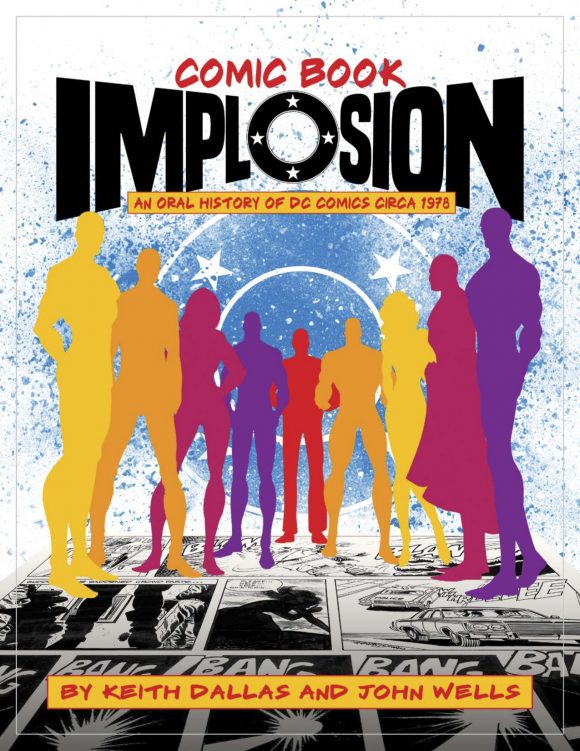
—
UPDATED 9/2/23: This year marks the 45th anniversary of 1978’s infamous DC Implosion. Perfect time for this “reprint” — an excerpt from Keith Dallas and John Wells’ superb Comic Book Implosion, from TwoMorrows. We serialized the book in three parts in 2018 and links to the other installments are below. The book is out of print but is still available digitally from TwoMorrows. Click here to order. Dig it. — Dan
—
TwoMorrows’ next history book, Comic Book Implosion, by Keith Dallas and John Wells, is an oral history of DC Comics in the late ’70s – a turning point in the publisher’s history.
After years of chasing Marvel, DC brought in Jenette Kahn as publisher with an eye toward rejuvenating the line, but forces both external and internal created a perfect storm that led to the infamous DC Implosion – the mass cancellation of titles that was deemed necessary to keep the company afloat.
Dallas and Wells culled a raft of periodicals and conducted new interviews with the important players and the result is a mind-bogglingly detailed account of what led up to the Implosion, the Implosion itself, as well as its aftermath. There are also essays, commentary and charts that help give context, plus a ton of memorable house ads that breathlessly hype whatever DC’s next big thing was supposed to be. (Click here for ordering info.)
Over three weekends, we’re serializing portions of the book with segments that detail specific developments before, during and after the Implosion.
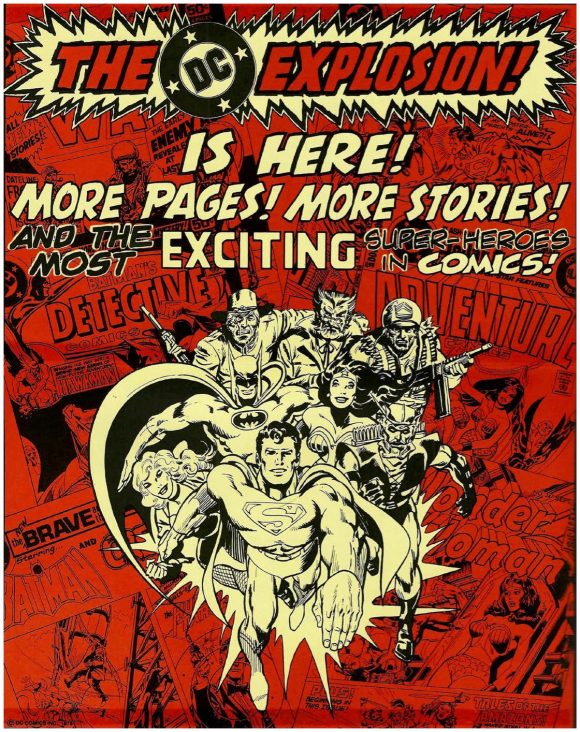
DC house ad. Primary art by Jim Aparo.
To kick off, here’s a look at the birth of DC’s Dollar Comics — an initiative that remains popular with long-time readers even today:
—
Jenette Kahn, then DC Comics publisher in an interview printed in Comic Media News #29 (January-February 1977):
I think that DC has always owned the younger market, Marvel the older market, and Gold Key the younger still.
As soon as you graduate into superheroes, you graduate into DC. Unfortunately, we didn’t have an upper area in which to move after you graduated from our younger comics—you had to graduate into Marvel. I think there’s a way to put out comics which find their own level, reach their own market, all under the same company’s roof.
Basically, Marvel Comics—which I admire; they have some wonderful writers and artists—unfortunately they are very hard for a kid to read. A 10-year-old kid who picks up The Avengers has to be very sophisticated or totally dedicated fan to get through it because it demands tremendous mental involvement. Even at 29, I find it a bit of a strain to read The Avengers, as much as I am thrilled by it. I picked up a copy of Cary Bates’ Superman and it’s so easy to read. Like Superman Family, it is pure entertainment. That’s a very important part of comics. (Though) it doesn’t mean The Avengers shouldn’t be brilliant. …
And, of course, there’s a certain amount of parental influence in the buying of comics. A kid is in the supermarket with his mother buying things and he decides he wants a comic. She won’t buy him one that looks violent, gory and horrid, but if it says ‘DC TV’ and she recognizes Isis, which her kid has been watching on Saturday morning TV, or Shazam!, Welcome Back, Kotter, or Super Friends, it looks all nice and familiar so she’s quite happy about buying those comics.
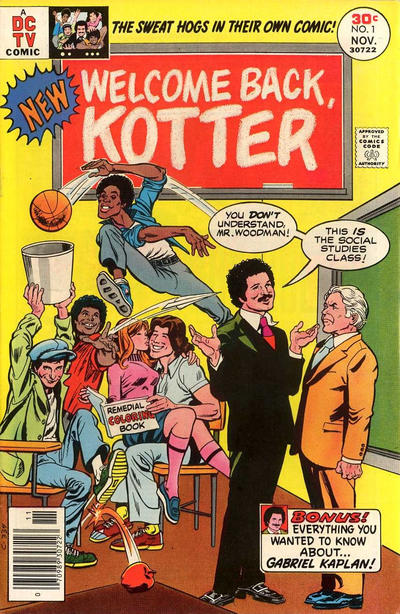
Bob Oksner
[Of the quartet, only Super Friends proved to be a real success, running for 47 issues into 1981. Isis and Kotter lasted a respective eight and 10 issues, neither making it to 1978 (other than a Kotter tabloid). Shazam! ended soon after in February 1978 but the feature survived as part of the World’s Finest anthology through 1982. (Curiously, the Wonder Woman comic book did not display a DC TV logo despite shifting its backdrop to World War II—effective with November 1976’s WW #228—to reflect the popular Lynda Carter TV series.) Kahn’s next attempt at rebranding a subset of the DC line was far more successful. In December 1976, the world was introduced to Dollar Comics.]
—
Mike Tiefenbacher, then editor of The Comic Reader in a news item printed in The Comic Reader #136 (October 1976):
Beginning in December, four titles, The Superman Family, House of Mystery, World’s Finest and G.I. Combat, will cost $1.00, and will be 80-page giants. Before mathematicians start figuring out comparative costs with former 80-pagers, we will mention that these books will contain 66 pages of new material—roughly four times the material contained in a 30¢ book. What these books will resemble for the most part are Golden Age titles, i.e., they will return the multi-character book to the stands.
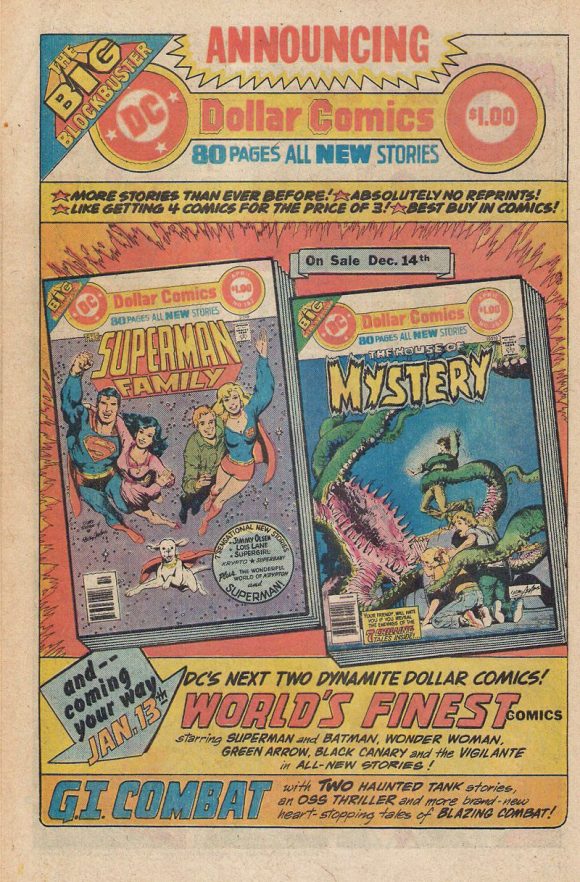
House ad
—
Jenette Kahn, then DC Comics publisher in an interview printed in Comic Media News #29 (January-February 1977):
The [current] package is absolutely untenable; 17 pages, and reprints, and a 30¢ cover price. There’s no place to go really. And yet there was a time when you paid 10¢ for a comic book and 10¢ for Time magazine. The trouble was that we didn’t keep up with the rest of the industry in price rises. Twenty years passed before we dared to make the great leap to… 12¢. Then we tried 15¢… then 20¢, 25¢, and now 30¢. But, still all that is too low. Time magazine is now $1.00, we should be $1.00, and that’s where we’re headed. It’s a major experiment but I think it’s the answer not just for us but for Marvel, Archie, any comic-book company.
The dollar package is just like the Golden Age format in that we will be having 80 pages, 14 of ads and 66 of all-new material.
It’ll be a change for writers and artists to do stories of any length that seems appropriate to the story rather than cramming it into a meager 17 pages. It is going to give the wholesaler and retailer a chance to make money. The retailer who for years has not wanted to carry comic books in his shop, saying, “Why should I? What does 50% off 30¢ mean to anybody? All they do is clog up my newsstand and keep people from buying Playboy and all those other money-making magazines.”
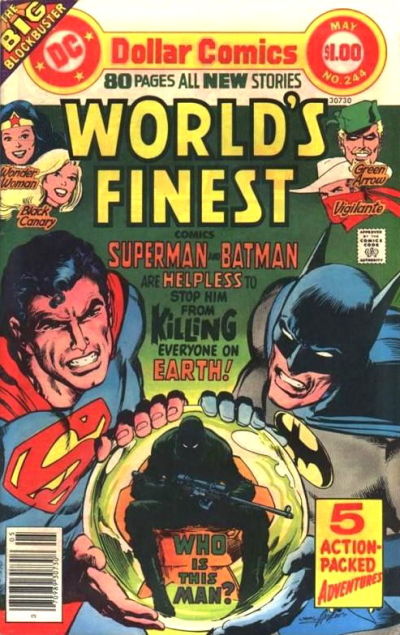
The first World’s Finest Dollar Comic. Art by Neal Adams.
Now a retailer can make more from selling a dollar comic book than he can from selling Time or Newsweek, because 50% off a dollar from us is more than 40% off a dollar from them.
So there’s something in it for him now, there’s something in it for the wholesaler. There’s certainly something in it for us because our economics are better. There is something in it for the writers and artists because they have more flexibility, more latitude—and they can make money too. Then there’s our reader. They are getting more editorial pages for their dollar than if they bought three and a third 30¢ comic books.
They will be getting more, better material because we’re paying more for our covers, getting people like Neal Adams, Bernie Wrightson and Curt Swan to draw them. We’ve designed the first dollar books to be anthology titles so that the reader doesn’t feel like he’s tying up all his money in one character.
In World’s Finest, for instance, there’ll still be Superman and Batman, but also Green Arrow, Black Canary, Wonder Woman, etc. More characters for his money. I hope this will make retailers carry comics who haven’t carried them before, and hopefully change the industry.
[Thanks to his new relationship with Kahn, Neal Adams returned to draw covers on several DC titles, including the early issues of the Dollar Comics. Superman Family #182, December 1976’s inaugural Dollar Comic, was a mixed bag. Sporting a lovely Curt Swan/Neal Adams cover image of smiling heroes, the issue incorporated Jimmy Olsen stories intended for the old 50¢ format and featured old-school characters like Superbaby and Krypto as well as Supergirl, Lois Lane and “The Fabulous World of Krypton.” Jaded, older fans scoffed; general audiences did not. As the rollout continued into 1977, the content of Superman Family and World’s Finest became more attuned to fan interests and sales kept rising.]
—
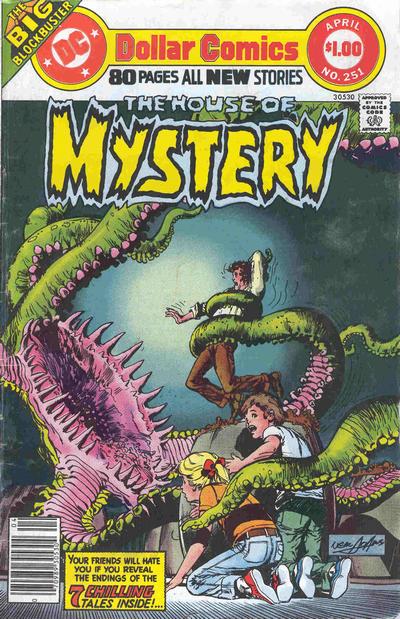
The first House of Mystery Dollar Comic. Art by Neal Adams.
Paul Levitz, then DC Comics Editorial Coordinator in an interview printed in The Comics Journal #39 (April 1978):
Very soon you’ll be paying 50¢ for a 17-page story. If, indeed, it’s even possible to do that five years from now. If [Dollar Comics] don’t succeed, comic books have a serious long-term problem. So we’ve gotta keep trying.
We can afford to try where Marvel can’t, because we’re part of a massive conglomerate that believes in thinking about things on a long-term basis and not worrying about the money that’s in their pocket today. Warner doesn’t have to worry. (Marvel owner) Cadence is a very small company, and it has very little money to play around with. They can’t afford the same courage, I suspect. We’re going to use our courage, we’re going to go out there. We think it’s a good idea. We think, in our own private thoughts, that it’s pretty much the salvation of the business. Creatively speaking, it’s the opportunity to do things which you can’t do in today’s comics.
Financially speaking, for the reader, I don’t think it’s a rip-off. Because you’re getting a comic—you’re paying a lot of money for it—but you’re getting something for it. I don’t think that’s really true of a 17-pager.
—
Mike Gold, then DC Comics public relations representative in an interview printed in Comic Media News #32 (August-September 1977):
The reason why the dollar books are doing so well and why we’re so optimistic about them is that they’re more profitable books for the retailer to have. So that a guy who doesn’t handle 35¢, or even 60¢ comics—a guy who is in an airport or shopping center—these types of places by and large do not handle comic books because the 6¢ to 8¢ they make off a 35¢ comic book is not worth the hassle, but on a dollar book they’re making good money. They’re making more than on a dollar copy of Time magazine as a matter of fact.
The way we have it set up, the books will be on the stands for two months; that’s the promise we made to these people. I don’t think we’ll change it until we have a full line of dollar books, rather than just the three we have scheduled at the moment. It’s such a beautiful system we have now there’s no reason to jeopardize it.
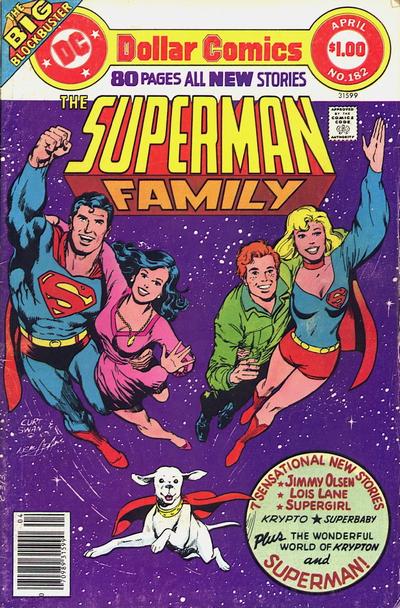
The first Superman Family Dollar Comic. Art by Curt Swan and Neal Adams.
The first Superman Family dollar book: I know the fans didn’t like it and I’m not going to apologize for that—the younger readers really did like it. That book was probably the most profitable, in terms of bucks, comic book to be published in maybe five years by anybody. It sold phenomenally well. [Since then, it has been] selling about 140,000 [copies per issue]. That’s a real rough estimate off the top of my head. But, every point above break even on a dollar book is three times more profitable than a point on a 35¢ comic—and the book came in about 12 points above break even. That’s phenomenal—that’s terrific!
—
News item printed in Mediascene #27 (September-October 1977):
According to Mike Gold, [Dollar Comics] seem to have a somewhat cumulative effect, not necessarily selling more on the regular newsstand, but selling in more non-newsstands. The average increase in sales after five issues has been about 200% in these grocery stores, mini-marts, etc. Sales on G.I. Combat alone have skyrocketed 320%, partly due to this increased marketing platform and partly due to Joe Kubert’s strikingly effective covers.
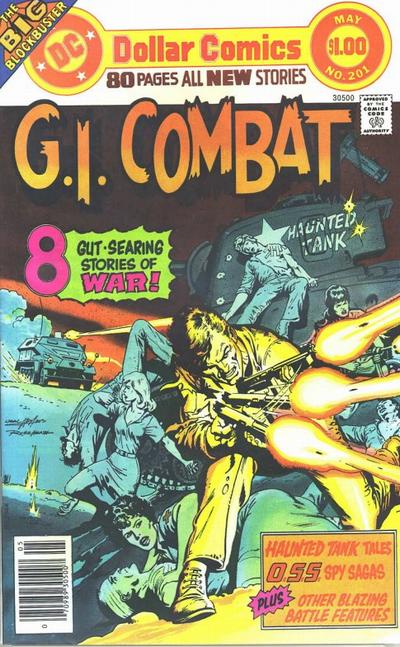
The first G.I. Combat Dollar Comic. Art by Neal Adams and Russ Heath.
[Some in the industry foresaw an endgame wherein new comic books would cease to exist, subsequently sustained only by old material culled from their archives. Harvey Comics was already mixing unidentified reprints with increasingly few new stories. Charlton, after shuttering its comics division on September 17, 1976, returned to spinner racks in the summer of 1977 with a line composed almost entirely of previously run content. Jenette Kahn recalled a conversation with Warner’s William Sarnoff before she was hired.]
—
Jenette Kahn, then DC Comics publisher in an interview printed in Back Issue #57 (July 2012):
Bill said, “We have four decades’ worth of comics, hundreds of titles, and we’re thinking we should reprint them since comics lose money and we make all our profits through merchandise and media.”
“That’s a really terrible idea,” I said (oh, the chutzpah of youth!). “It’s the ongoing exploits and new adventures of the characters that are the lifeblood of the company and make licensing and media possible. If you don’t publish new stories, the characters will have a radioactive half-life and eventually all the media and merchandise will disappear.”
[Kahn put her words into action and stamped out the reprints that had supplemented multiple DC titles over the past several years. Each of DC’s 48-page giants—Batman Family, DC Special, DC Super-Stars, Super-Team Family—shifted to all-new content in 1977 while the Limited Collectors’ Edition tabloids were revised initially as “Best of…” showcases that collected material like the early 1970s Batman/Rā’s al Ghūl serial by Denny O’Neil, Neal Adams, Irv Novick, and Dick Giordano. Similar treatment was afforded Len Wein and Bernie Wrightson’s celebrated Swamp Thing stories (1972-1974), which were collected two at a time in editions with new wraparound covers by Wrightson.]
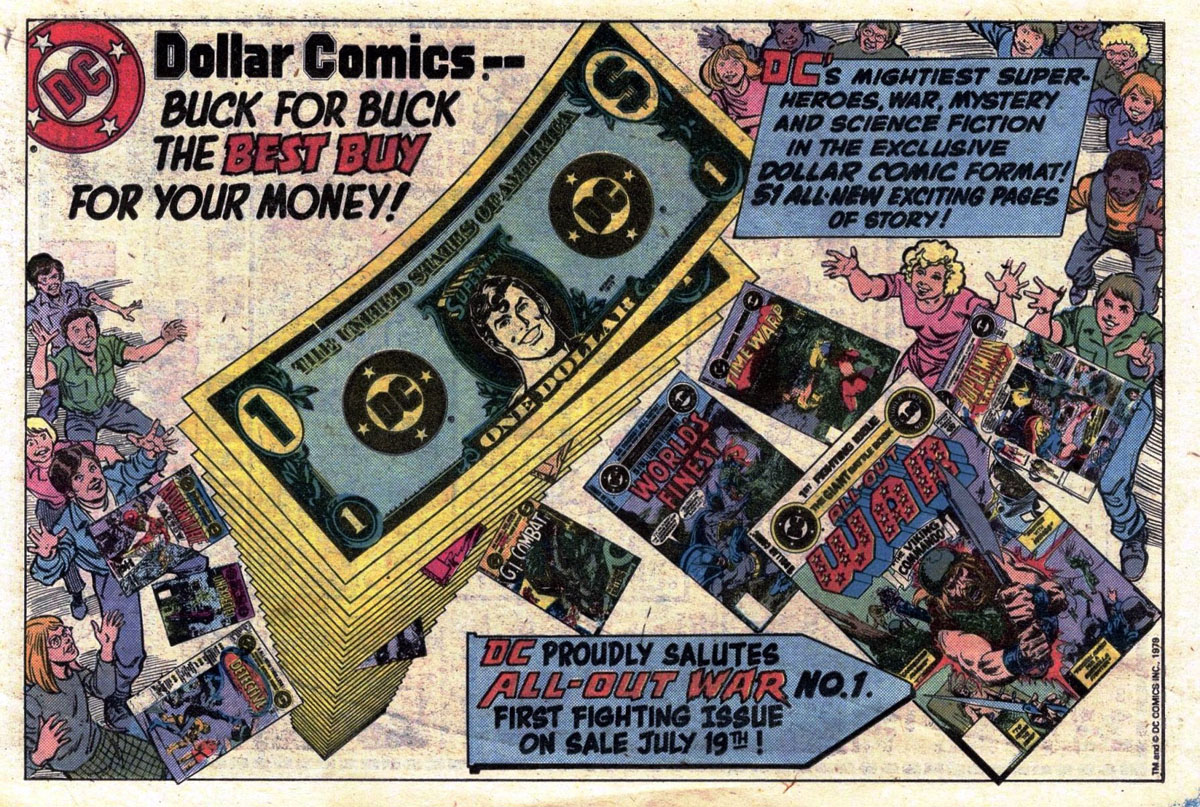
House ad
—
Jenette Kahn, then DC Comics publisher in an interview printed in Comic Media News #29 (January-February 1977)li:
I don’t really believe in reprint books unless you have a very good reason for reprinting a particular story. Reprints have no justification except that you want them to pad out a comic. Now, there are some classic stories that truly deserve to see the light of day again, for example, the Rā’s al Ghūl four-part story from Batman. It’s a wonderful story that we’ll be reprinting complete very soon. So that’s a good reprint, but reprinting for the sake of money is a terrible idea.
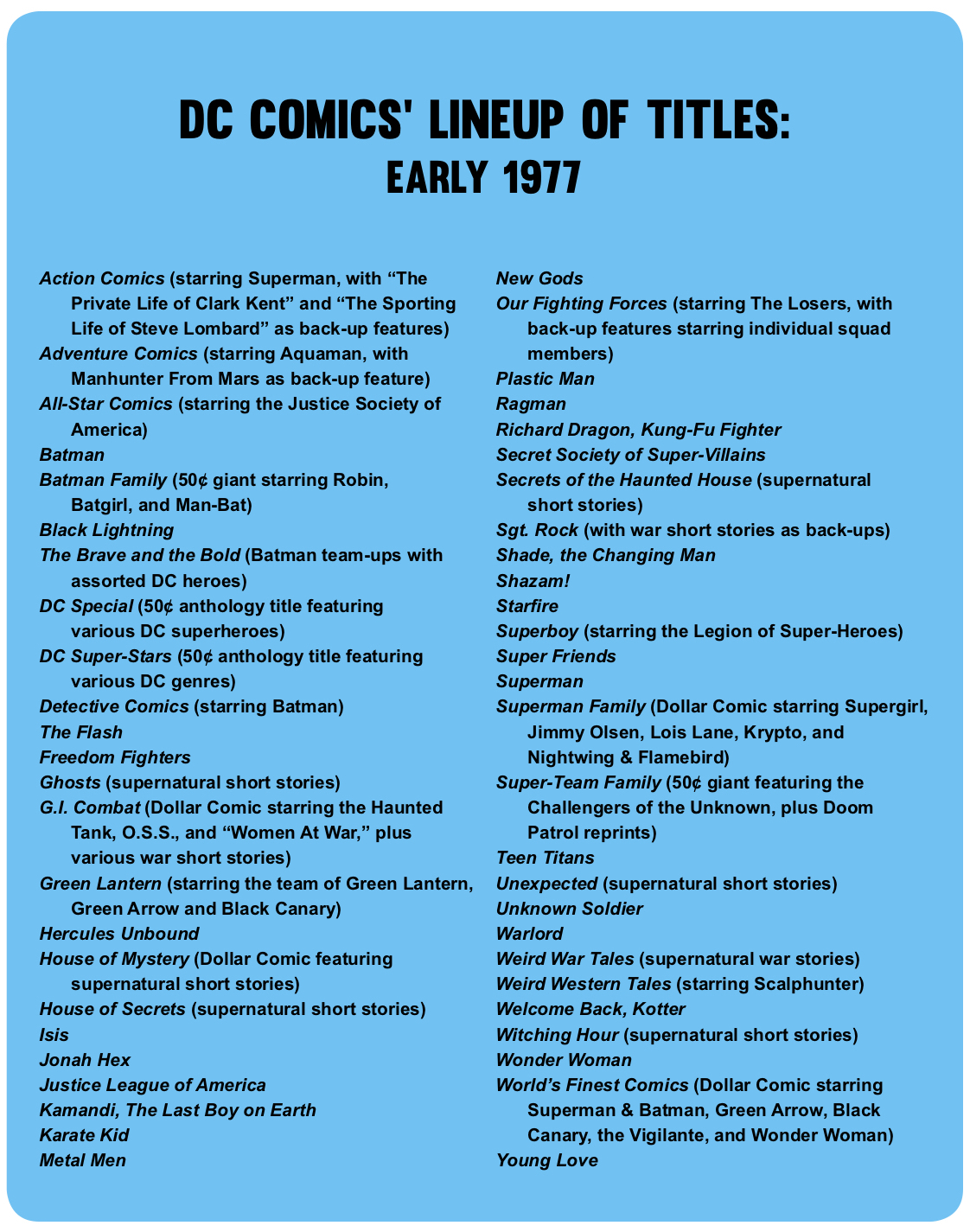
—
MORE
— THE DC IMPLOSION: When the Ax Fell. Click here.
— AFTER THE IMPLOSION: Cancelled Comic Cavalcade. Click here.
—
Comic Book Implosion is a 136-page, oversized, illustrated trade paperback that lists for $21.95. It will be available in comics shops, online retailers and through TwoMorrows directly during the week of July 23. (Click here.)

March 12, 2022
I loved these1 Oh, and I was a jaded college kid at this time but I loved the Krypto solo stories in (I think!) Superman Family! I got to re-read them a decade ago and thee storyline is still fun!
June 4, 2022
So why did the Dollar Comics disappear if they were so lucrative? The same rationale was tried in 1974 when the 100 Page Super-Spectacular comics briefly became DC’s standard format for many titles. Same arguments: the retailers will make more money per unit, so they will be motivated to carry them and display them prominently. Didn’t really work out, and the format all but disappeared by 1975. And what really drove Marvel past DC for the first time was the period in 1972 when DCs cost 25 cents and Marvels cost 20 cents. Seems like the lesson was, as long as kids were buying them, or parents were buying what they thought of as junk entertainment for the kids, then the lowest price per issue is what would sell. Don’t get me wrong, I loved and still love all those DC Giant formats. I’m just mystified at how they kept trying variations on the same idea that never seemed to work out long term.
June 4, 2022
I think what really ended them was the rise in price for the regular size comics. With them edging toward a dollar, it was clear the dollar comics would no longer stay at that price. I’m guessing the heads at DC questioned whether they would still sell at a higher price. It also may have been the nature of the stories, which were mostly done in one, while the regular DC comics were shifting toward continuing stories, which appealed to the hardcore fans. But as DC and other comics companies shifted their focus on the hardcore fans (with comics shops gaining prevalence), they neglected the casual and younger readers so that they almost don’t exist anymore. Archie Comics was an exception, producing digests with the reprinted material and found in many supermarkets for many years.
June 5, 2022
Yes, that’s true by 1982 when only 3 Dollar Comics remained, as it turned out 3 of the 4 they originally launched: Superman Family, Worlds Finest & GI Combat. By the summer of that year Superman Family was cancelled, Worlds Finest reverted to standard size, and GI Combat continued as an oversized comic, but no longer branded as a Dollar Comic, and with a price that fluctuated for a while between $1 and $1.50. At that point the difference between standard and Dollar Comics was 60 cents versus $1. But prior to 1982 DC consistently was abandoning the number of titles at that higher price point. Off the top of my head, Detective, Adventure, House of Mystery, Unexpected all reverted back, and a few others were launched as Dollar Comics and promptly cancelled, such as Time Warp & All-Out War. Seems the higher price point again wasn’t enough to motivate greater newsstand distribution, just as before with the 100 Page Super Specs and 52 Pages Bigger & Better formats of the early 1970s.
June 8, 2022
When I sold off my comic collection I my dollar size Batman Family/Detective Comics and World’ Finest Comics.
Love those comics and stories.
September 2, 2023
Really enjoyed the variety the Dollar Comics offered. The closest thing to them DC has produced since were the comics they distributed through the Walmart trading cards jobber. Had they been able to distribute them through the magazine vendor or Walmart itself, I think they would have done better.
September 4, 2023
I live these books! My first sale to DC was a “World of Krypton” story for the first $1 issue of SUPERMAN FAMILY, my second the framing sequence to the first $1 ish of HOUSE OF MYSTERY. With so many pages to bury bad work in editors could afford to take chances on newbies like me!